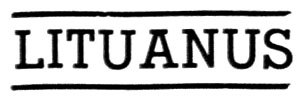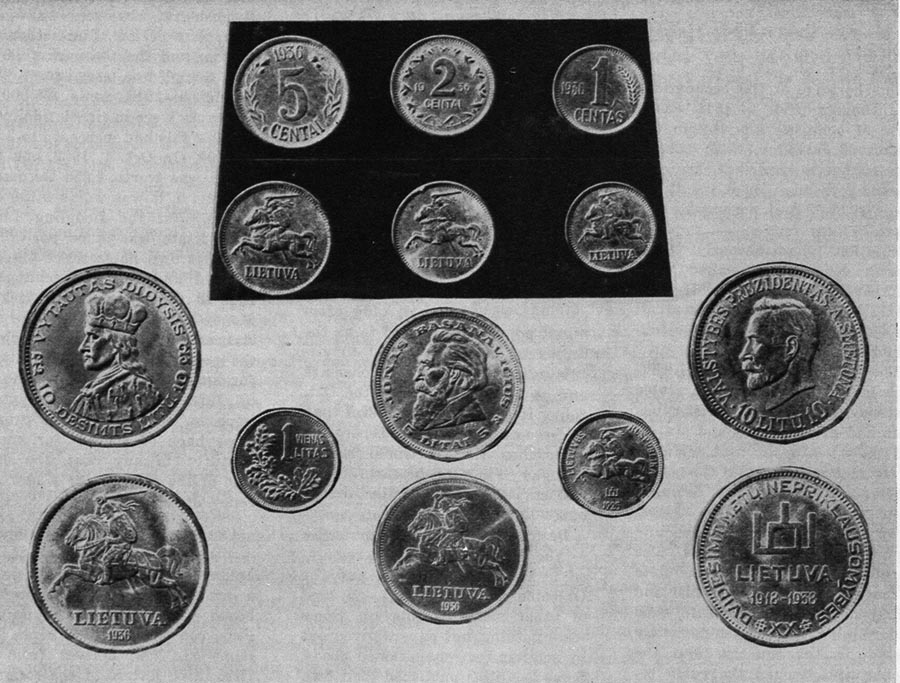
Managing Editor P. V. Vygantas
 |
www.lituanus.org |
|
Copyright
© 1957 Lithuanian
Students Association, Inc.
December,
1957 No.4(13)
Managing Editor P. V. Vygantas |
|
THE CURRENCY OF INDEPENDENT LITHUANIA
K. Skr.
This article is based on a recent book in Lithuanian with a summary in English by Jonas K. Karys, NEPRIKLAUSOMOS LIETUVOS PINIGAI (The Money of Independent Lithuania).
One heritage of the occupations of Lithuania prior to 1918 was a state
of complete anarchy in the matter of currency. Each successive
conqueror had left his own monetary system; as a result between 1916-22
four nationwide and several local currencies were in circulation
simultaneously. This chaotic condition prevailed until 1922, at which
time the four-year-old Lithuanian state abolished all the existing
currencies and established its own system.
The German invaders of Lithuania in 1914 found there a stable currency, the Russian Czarist ruble. This had provided a sound system for many years, one that performed its functions and that the people trusted. The occupiers brought their own currency, the Reichs-mark, and this slowly entered into competition with the ruble. The German policy was to accumulate as many rubles as possible and sell them in neutral markets, thus undermining the Czarist monetary system in the country. But the people who trusted the ruble reacted by hoarding it, and the result was a great scarcity of circulating media, although the German mark gradually drove out the Russian rub!e. The situation was grave, and by order of the German military command a new ruble, called the Ostruble, consisting of 100 kopeks, was issued by the Darlehnkasse Ost and on Aug. 6, 1916, was declared legal tender. The notes were authorized in a sum of up to 100,000,000 marks, and were actually receipts for collateral deposited in the treasury. The Ostruble was equal in value to one Czarist ruble or two German marks. It was intended not only to perform the usual exchange functions but also to drive out the Russian ruble once and for all. But the population was still reluctant to part with its "good" rubles. Black markets sprang up, and the exchange rate fluctuated to the substantial disadvantage of the new currency. The exact number of Ostrubles issued for the total area in which they circulated (they were intended not for Lithuania alone but for all the Eastern provinces) remained a "military" secret, but experts estimate the figure at some 207,-000,000.
Although the Ostruble was never recalled, as was promised on the notes, the same bank in 1918 issued still another type of currency. This was the mark (100 pfennigs), popularly referred to as the Ostmark. It was intended to circulate at par with the Reichsmark and at half the value of the Ostruble. It was more successful than its predecessor, possibly because of a promise that it would be exchanged for Reichsmarks. The czarist ruble was finally driven out.
Besides these official currencies — the Reichsmark, which remained in limited circulation, and the Ostruble and Ostmark — a host of other media sprang up. Some were nothing but papers given out by soldiers for requisitioned goods. Some localities published their own notes, which of course were worthless, and there was a heavy influx of rubles published by the Soviet revolutionaries. These were carried by the Soviet Army and returning from Russia Lithuanian refugees and were a great hindrance to the Lithuanian state in its efforts to establish some order. They quickly disappeared, however, and when the new currency was established in 1922 these rubles were not convertible.
The greatest barrier to monetary order was the government's fiscal position. An immediate source of funds was imperative, and the only possible source was foreign loans. Several loans were obtained from Germany, but in return Lithuania had to surrender her issuing rights in favor of the Dailehnkasse Ost and to declare the Ostmark legal tender. The Reichsmark, however, was going through a period of disastrous inflation, and the Ostmark followed suit, though to a leser extent. Thus in March, 1918, some 166,000,000 Ostmarks were in circulation, while by 1922 this had increased to 3,500, 000,000. On Oct. 1, 1922, one U.S. dollar was worth 1,650 Ostmarks; by Nov. 8, it was worth 9,150 Ostmarks. But the fledgling Lithuanian state was in no position to issue its own notes, since reserves of gold and foreign exchange in 1918-19 were completely lacking. Money issued under such circumstances could not possibly obtain the people's confidence or attract foreign creditors. Not until the fall of 1922 did economic conditions improve sufficiently to promise some hope of success for such a venture; in any case, the inflation of the mark made a new currency imperative.
On Aug. 9, 1922, after several months of preparation, the Lithuanian Seimas (Parliament) passed a law establishing a new currency based on the monetary unit of litas, consisting of 100 cents. The name "LITas" derives from the first three letters of the country's name. The litas contained 0.150462 grams of gold and was by law directly convertible into gold. Its gold content amounted to about one-tenth that of the American dollar, which at that time represented 23.22 grains of gold. In the same year the Bank of Lithuania, a corporation half of whose shares were state owned, was set up and given a 20-year concession to issue notes. On Oct. 1, 1922, the litas was declared legal tender in the Republic of Lithuania; all other legal currencies were to be converted within three months. Debts contracted in all the old forms of currency were revaluated in terms of the litas. This revaluation was a difficult task, since both the Reichsmark and the Ostmark were fluctuating by the hour. Many laws and administrative directives were adopted to aid in the solution of this problem. In some cases the debt was revaluated in terms of the rate of exchange at the time the debt was contracted; in other cases fixed rates of exchange were provided. A limited issue of temporary notes was immediately circulated, to serve until permanent notes could be printed. The permanent notes appeared in denominations of from one cent up to 1,000 litas. The notes were colorful and of a complex design. It is interesting to note that successful counterfeiting was rare in Lithuania, although it had flourished during the "Ost" money period. The total circulation of the new currency reached a peak of 205,850,000 litas in 1939, and the highest per capita circulation — 69 litas — was atained in January, 1940. Gold reserves now were sufficient to cover — and sometimes more than cover — the total issue. The litas was never devalued; with the reduction of the gold content of the American dollar, the litas was valued at $0.1664.
No coins were minted until 1925, when silver and aluminum bronze coins appeared. The one-, five-, ten-, 20- and 50- cent pieces were 90% copper and 10% aluminum; the one-, two- and five-litas coins were 50% silver and 50% copper. They were made at England's Royal Mint & King's Norton Metal Works, since Lithuania had no mint of its own until 1936. The mint established in Kaunas in that year minted one-, two- and five-cent and one-, five- and ten-litas coins from plates prepared in Belgium. These coins differed from the earlier coins in their design and metal contents. The percentage of silver in the silver coins was increased to 75%. The law provided for free coinage of gold, but no gold coins were minted. The law regulated the amount of money permitted to circulate in the form of coins; 34,870,000 litas in silver coins and 5,050,000 litas in bronze coins — about half the permissible amount — was in circulation in 1939. Still another law provided that no one could be forced to accept coins in excess of certain fixed sums — 15 litas for bronze coins and 600 litas for silver ones. The Bank of Lithuania would exchange other circulating media for coins if the latter were presented in sufficient amounts — a minimum of 50 litas for bronze pieces and 500 litas for silver ones.

A sample of Lithuanian coins
Thus after several years of chaos the state of Lithuania established monetary order by creating its own currency, the litas. However, this currency was destined to last only 19 years. It disappeared with the Soviet occupation of Lithuania. At first the Soviet regime permitted the litas — devalued to 90 kopeks per litas — to circulate with its own ruble. The devaluation was intended to drive out the litas, but again the people held on to their trusted money. As a final resort the Soviet regime declared the use of the litas, to be strictly forbidden as of March 25, 1941. This act wrote finis to the brief history of the litas.